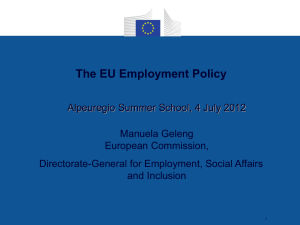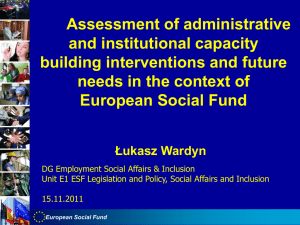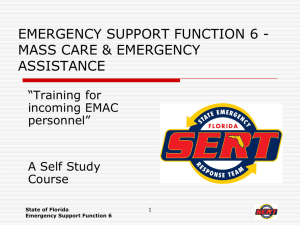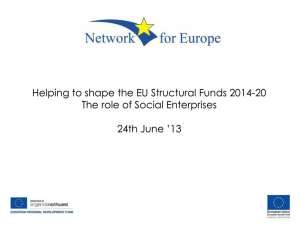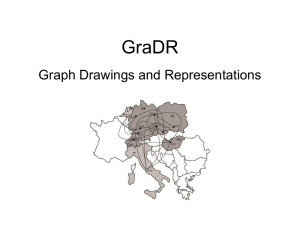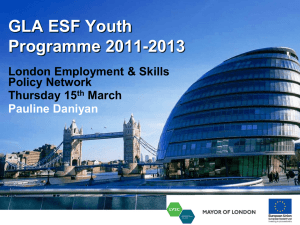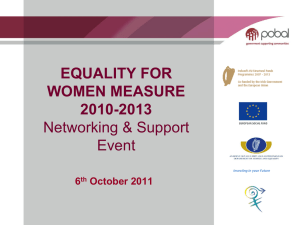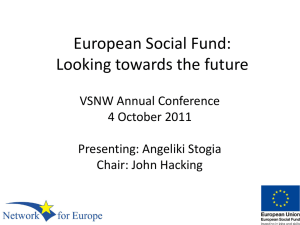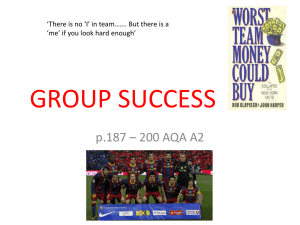Dominique Be
advertisement
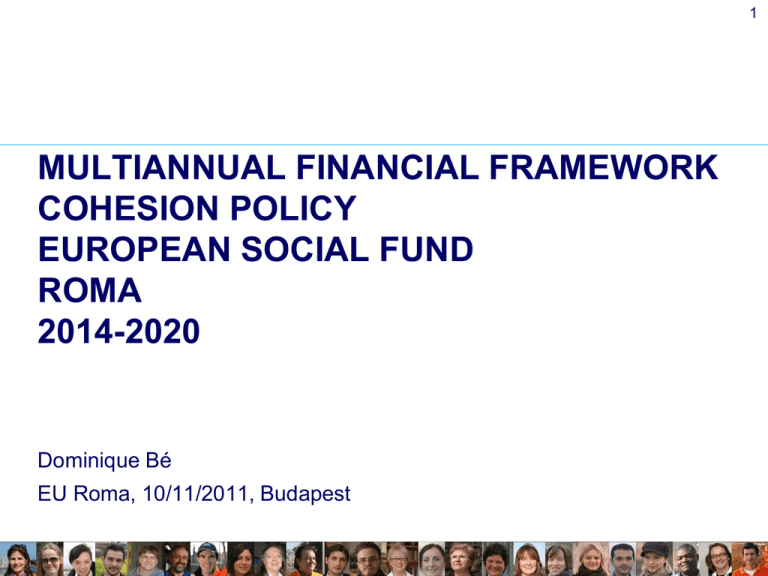
1 MULTIANNUAL FINANCIAL FRAMEWORK COHESION POLICY EUROPEAN SOCIAL FUND ROMA 2014-2020 Dominique Bé EU Roma, 10/11/2011, Budapest 2 Multiannual Financial Framework 2014-2020: €1,025 billion global Europe 7% security & citizenship 2% sustainable growth 37% administration 6% Other 48% cohesion policy 33% competitiveness 11% infrastructure 4% as % of total € bn 2011 prices 3 Multiannual Financial Framework Key planning & delivery principles focus on results increased use of conditionality simplification of delivery cost effective accountability (proportionality) reducing administrative burden for beneficiaries different programmes under single framework with common rules mainstreaming horizontal priorities (ex: climate action) leveraging EU funds 4 Cohesion policy post 2013 3 complementary Funds focused on thematic objectives ESF competitiveness of SMEs education, skills & life-long learning employment & professional mobility environment, climate health, education & social infrastructure ERDF Cohesion fund institutional capacity R&D & innovation services general economic interest social inclusion & poverty reduction telecom, energy & transport urban development 5 Cohesion policy post 2013 €376.02 bn – 2014-2020 Territorial cooperation 3% Connecting Europe Facility 11% Cohesion Fund 18% less developed 44% ESF + ERDF 69% transition 10% more developed 14% 6 Cohesion policy post 2013 3 types of regions with focused priorities less developed transition convergence 75% 90% GDP/capita EU average crossborder territorial cooperation transnational inter regional more developed competitiveness 7 Cohesion policy post 2013 eligibility simulation GDP/capita* < 75 % of EU average 75-90 % > 90 % *index EU27=100 3 categories of regions less developed regions transition regions more developed regions Canarias Madeira Guyane Réunion Guadeloupe/ Martinique Açores Malta 9 Cohesion policy post 2013 ESF ≥ 25% Cohesion policy budget 50% existing 2007-13 ESF share 45% "potential" 2007-13 ESF share 40% 35% 30% 25% 20% 15% 10% 5% this graph shows the impact the 25% rule would have had in 2007-13 0% EE LV SK MT CZ HU PL LT BG SI CY RO EL ES IT PO DE AT FI SW FR LU DA IE UK NL BE 10 Cohesion policy post 2013 Capping: max. 2.5% of GNI 92% 68% 69% 72% 94% 73% in several Member States because of GNI capping Cohesion policy allocations would be reduced compared to their 2007-13 allocation 2007-13 2014-20 HU 93% LV LT EE CZ BG PL 11 Cohesion policy post 2013 Delivery shared management national co-financing higher EU co-financing rate for MS receiving financial assistance multi-funds programmes as an option e.g. human capital & infrastructure investments performance reserve 5% of cohesion policy budget allocated at mid-term review 12 ESF REGULATION 2014-2020 Proposal from the European Commission 13 ESF Regulation post 2013 Mission economic, social & territorial cohesion employment & job quality geographical & occupational mobility adaptation to change, education & training gender equality, equal opportunities & non discrimination social inclusion & fight against poverty Europe 2020 priorities & targets integrated guidelines for economic & employment policies Council Recommendations on NRP focus on disadvantaged groups, new challenges, good governance, reforms 14 ESF Regulation post 2013 4 priorities x 4 objectives SME competitiveness institutional capacity & administration RDT&I social inclusion & fight >< poverty digital agenda education, skills & LLL green skills & jobs employment & labour mobility 15 ESF Regulation post 2013 Scope (I) employment, geographical & occupational labour mobility access to employment & labour mobility labour market integration of NEET self employment, entrepreneurship & business creation gender equality & work-life reconciliation adaptation to change active & healthy ageing quality labour market institutions, incl. geographic mobility education, skills & LLL fight against early school leaving access to quality education at all levels & quality LLL 16 ESF Regulation post 2013 Scope (II) social inclusion & fight against poverty active inclusion integration of marginalised communities such as the Roma anti-discrimination quality heath care & social services of general interest social economy & enterprises community-led local development strategies institutional capacity & efficient public administration administrative capacity in “less developed” MS capacity of stakeholders delivering employment, education & social policies 17 ESF Regulation post 2013 Scope (III) within above priorities, contribution to green skills & jobs education & training systems reform, upskilling, green jobs digital agenda digital literacy, e-skills, e-inclusion RDT&I post-graduate studies, training of researchers networking activities for higher education institutions, R&T centres & enterprises SME competitiveness adaptability & human capital 18 ESF Regulation post 2013 Consistency & thematic concentration consistency with NRP & related Council recommendations focus on disadvantaged groups min. 20% ESF to social inclusion & fight against poverty thematic concentration (of each OP) on employment/mobility, education/training, social inclusion & institutional capacity 80 % more developed 70 % transition 60 % less developed 19 ESF Regulation post 2013 min. 20% ESF for social inclusion 40% 35% existing 2007-13 social inclusion share this graph shows the impact the 20% rule would have had in 2007-13 30% 25% 20% 15% 10% 5% 0% DK EE SW PO LT LV SI BG HU CZ ES RO PL IT CY EL LU SK FI MT AT DE UK BE NL IE FR 20 ESF Regulation post 2013 Horizontal principles partnership global grants for social partners & NGOs capacity building in less developed regions/MS for social partners, including joint actions NGOs social inclusion, gender equality & equal opportunities 21 ESF Regulation post 2013 Financial management simplified cost options permitted up to €100K grants standard scales of unit costs & lump sum grants mandatory for grants < €50K 22 MFF, Cohesion Policy & ESF Post 2013 http://ec.europa.eu/budget/reform http://ec.europa.eu/esf
